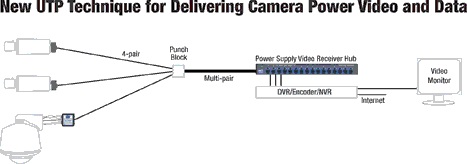

The evolution of network video systems will be budget-, need- and choice-based.
At its best, video IP is implemented to sharing of financial resources, system control, maintenance and the expansion to interconnect all facets of voice, data and video over the same physical infrastructure. It has promised functionality but it is still pretty expensive if you implement network camera-based specification. This article will review the system choices and recommend a way to integrate IP into your existing CCTV network at minimum cost and provide maximum future financial flexibility.
Fact is, analog equipment is widely installed and will continue to work successfully and reliably. These cameras also have the availability, correct price point and functionality needed to do the job. On the other hand, IP-based video has many compelling features such as remains a promise currently being hyped and sold into applications that represent a small percentage of the industry. In reality, analog or IP is really no more or less than an additional product choice, with advantages and disadvantages that are not yet well understood. CCTV systems have been and will remain for the foreseeable future, a combination of analog and digital systems also known as 'hybrid systems'.
To maximise the customer's technology choices at the camera, the transmission system and the head end, CCTV systems suppliers and integrators are scrambling to provide products that 'connect the dots' between installed analog and digital equipment and between security- and IT-based perspectives. Integrators and end-users want to be sure that their system choices provide an upgrade path that is forward-compatible with a future of fully digital architecture, without throwing out perfectly good analog equipment.
From all this uncertainty, one fact stands out: IP-based systems will use UTP-based structured cabling as the transmission medium. Fortunately, there is a way to implement a cost effective hybrid UTP system that gives customers the product choices they need: a UTP-based hybrid solution. Such a choice supports today's cost effective analog systems while providing the IP ready cabling infrastructure when a switchover does occur.
The key is UTP
Coax is obsolete. It is much too heavy, has poor interference immunity, is difficult to terminate, and more importantly, has no digital future. In addition, coax has no place in and does not comply with, structured cabling standards-based protocols such as EIA/TIA568B. UTP wire supports these structured cabling standards and provides the ultimate migration path to a hybrid or all-digital solution. Far too many integrators and their customers are unaware of this simple enabling technology.
Hybrid solutions - power-video-data (PVD) all-in-one standard 4-pair UTP cable
Joining analog equipment to the digital future requires the adoption of UTP as the transmission medium. Today, there is a full range of UTP 568B-compliant CCTV transmission products featuring RJ45 connectivity. Installers who want to implement a digital-ready structured cabling system that easily supports a wide variety of existing analog products, a PVD solution supports cameras with a single 4-pair cable. Installers can deliver a high quality picture over the same infrastructure used by Ethernet datacom systems. In fact, most facilities already have UTP cable for their phones and datacom needs.
Network video technologies (NVT) power-video-data (PVD) products now let installers standardise their structured cabling in accordance with 568B wiring protocols, reduce installation time, and fully prepare the plant wiring for future digital systems when desired. This product range also allows installers to deliver camera power at distances up to 850 feet to a fixed camera. Installers and their users can select among the 8-channel, 16-channel, and 32-channel rack-mountable hubs with RJ45 video inputs for passive-to-passive multichannel applications under 750 feet and passive-to-active multichannel applications up to 3000 feet.
It all comes together
The PVD solution provides a convenient, cost effective and future-proof way to connect power, video and data from the camera to the control room. These products provide interference rejection that allows video signals to co-exist in the same wire bundle as telephone, datacom or low-voltage power circuits. This allows the installer to fully leverage the existing cabling infrastructure in accordance with 568B wiring standards, while reducing costs and time of installation.
At the camera
When used at the camera, the passive NV-218A-PVD transceiver connects directly to the camera's power, video, and (if needed) data. On the 'house' or output side of the NV-218A-PVD, installers simply connect via an RJ45 to the UTP going back to the wiring closet or IDF room. RJ45 wiring pin-outs are compatible with the datacom and telecom industry standard EIA/TIA-568B, so termination mistakes are minimised and testing is standardised. Using the advantages of a structured cabling system and star-wired layout, power supplies can be centrally located in the wiring closet or IDF.

At the wiring closet star topology wiring is key
At the wiring closet, the video, power and data signals arrive from each camera, and are routed though a cable integration product, either the four channel NV-704J-PVD or the 16 channel NV-716J-PVD. This wiring closet is the location for the camera power supplies. The cable integrator routes low-voltage camera power from any third-party Class 2 power supply via the same UTP cable as the video and data and delivers it to the camera. On the output side of the cable integrator, video and data are interconnected to the house wiring or UTP backbone and delivered to the control room.

House backbone wiring
Control room video and data connections are achieved via 4-pair UTP with RJ45 connectors into either a passive or active receiver hub, depending on the distance requirements of the camera runs. P/T/Z data connections are made into either a matrix or DVR.
Hybrid UTP brings together analog and digital
This is where the UTP system really shines. The UTP-based PVD solution is easy to install and manage cost effectively today. No matter where the digital market goes, once UTP is installed, product and technology choices are maximised. You can connect anything you want and never look back on the decision. UTP hybrid systems are a win-for-today solution becoming a win-for-tomorrow solution.
Guy Apple is the vice president of Network Video Technologies (NVT).
For more information contact Steve Proctor, Network Video Technologies, +44 (0) 208 977 6614, [email protected], www.nvt.com

© Technews Publishing (Pty) Ltd. | All Rights Reserved.